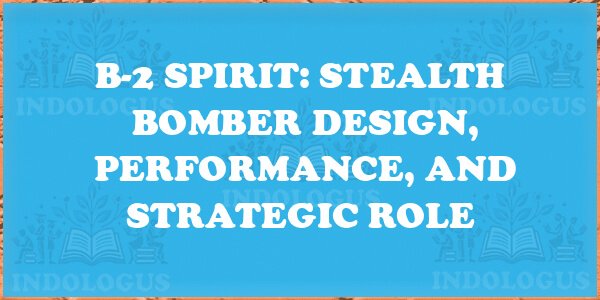The Northrop B-2 Spirit is a U.S. heavy strategic bomber designed to evade detection using advanced stealth technology, allowing it to operate in areas with dense air defense systems. It is commonly known as the stealth bomber.
Design and Stealth Technology
- Flying Wing Configuration: The B-2’s flying wing design enhances stealth by reducing radar cross-section and improving aerodynamic efficiency.
- Radar Absorbent Materials (RAM): Advanced composite materials and RAM coating make the aircraft nearly invisible to radar systems.
- Heat Signature Suppression: Engine intakes buried within the wing and infrared signature reduction techniques minimize detection.
- Electronic Countermeasures: Active jamming systems protect the B-2 in high-threat environments.
Performance and Specifications
| Feature | Specification |
|---|---|
| Manufacturer | Northrop Grumman |
| Role | Strategic Bomber |
| First Flight | July 17, 1989 |
| Introduction | January 1, 1997 |
| Number Built | 21 (including one test unit) |
| Crew | 2 (Pilot and Mission Commander) |
| Wingspan | 172 ft (52.4 m) |
| Length | 69 ft (21 m) |
| Height | 17 ft (5.2 m) |
| Max Takeoff Weight | 336,500 lbs (152,200 kg) |
| Range | 6,000 nautical miles (11,100 km) unrefueled |
| Speed | High subsonic (~Mach 0.95) |
| Service Ceiling | 50,000 ft (15,240 m) |
Payload and Weapons Systems
- Payload Capacity: Up to 40,000 pounds of mixed ordnance in internal bomb bays.
- Nuclear Capability: Certified to deliver B61 and B83 nuclear gravity bombs.
- Conventional Weapons: Includes JDAMs, GBU-57A/B Massive Ordnance Penetrator, and Smart Bombs for precision strikes.
Avionics and Systems
- Integrated Avionics Suite: Digital fly-by-wire system, glass cockpit, and real-time mission updates.
- Satellite and Secure Communications: Constant contact with Global Strike Command for targeting and battle management.
- Navigation Systems: INS, GPS-aided navigation, and TERCOM for precise low-altitude ingress.
Operational History and Combat Use
- Combat Missions: Engaged in Kosovo War, Afghanistan, Iraq War, Libya, and ISIS Campaigns with precision strikes.
- Global Reach: Intercontinental strike capability with air-to-air refueling support.
Strategic Role and Modernization
- Nuclear Deterrence: Forms part of the U.S. nuclear triad for airborne deterrence in nuclear conflicts.
- Conventional Dominance: Key role in deep-strike operations in A2/AD environments.
- Ongoing Upgrades: Modernization efforts include next-gen communications and integration of new nuclear weapons.
Limitations and Challenges
- High Maintenance Requirements: Intensive maintenance due to stealth coating.
- Cost: Each B-2 costs around $2.1 billion, making it one of the costliest military aircraft.
- Limited Fleet: Only 20 operational aircraft, necessitating careful deployment.
The Future: B-21 Raider Transition
- B-21 Raider: To replace the B-2 with improved stealth, automation, and operational capabilities.
- Transition Plan: Aimed for complementing or replacing the B-2 by the late 2030s.
Key Takeaways for Competitive Exams
- The B-2 Spirit is a stealth bomber with advanced design and technology for enhanced survivability in combat.
- It serves strategic roles in nuclear deterrence and conventional deep-strike operations.
- Ongoing modernization efforts aim to keep the B-2 operational and relevant until the introduction of the B-21 Raider.




